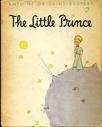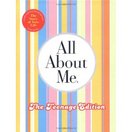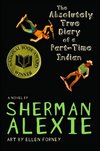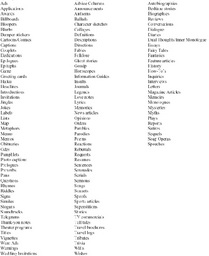Unit 2: Discovering the Individual- Who Am I?
Essential Questions:
- How have I been treated in the past by others? How do I/will I treat others in my life?
- What makes me unique? What are some aspects of my personality that seem “different” to others? How can I be proud of those? What do I like about myself?
- Where do I fit in society? How do my actions impact those around me?
- What is discrimination and what does it do to people? How have I been discriminated against in the past? How can I make sure I don’t discriminate against others? How do I see social pressures influencing discrimination?
- What do I believe (about myself and others, and about my morals and values)?
Materials Needed:
- Copies of each novel in the unit for each student
- Photo-copied sheets of All About Me: Teenage Edition for each student
- Three-ring binders/notebooks that allow students to add their journal materials
- Cameras to take pictures of students (an option to include in their multimedia projects)
- Craft supplies to create multimedia projects (newspaper/magazine clippings, construction paper, printed pictures, markers etc.)
Standards:
Reading:
2. Determine a theme or central idea of a text and analyze its development over the course of the text, including its relationship to the characters, setting, and plot; provide an objective summary of the text.
3. Analyze how a text makes connections among and distinctions between individuals, ideas, or events (e.g., through comparisons, analogies, or categories).
6. Determine an author’s point of view or purpose in a text and analyze how the author acknowledges and responds to conflicting evidence or viewpoints.
2. Determine a theme or central idea of a text and analyze its development over the course of the text, including its relationship to the characters, setting, and plot; provide an objective summary of the text.
3. Analyze how a text makes connections among and distinctions between individuals, ideas, or events (e.g., through comparisons, analogies, or categories).
6. Determine an author’s point of view or purpose in a text and analyze how the author acknowledges and responds to conflicting evidence or viewpoints.
Speaking & Listening:
1. Engage effectively in a range of collaborative discussions (one-on-one, in groups, and teacherled) with diverse partners on grade 8 topics, texts, and issues, building on others’ ideas and expressing their own clearly.
a. Come to discussions prepared, having read or researched material under study; explicitly draw on that preparation by referring to evidence on the topic, text, or issue to probe and reflect on ideas under discussion.
d. Acknowledge new information expressed by others, and, when warranted, qualify or justify their own views in light of the evidence presented.
2. Analyze the purpose of information presented in diverse media and formats (e.g., visually, quantitatively, orally) and evaluate the motives (e.g., social, commercial, political) behind its presentation.
1. Engage effectively in a range of collaborative discussions (one-on-one, in groups, and teacherled) with diverse partners on grade 8 topics, texts, and issues, building on others’ ideas and expressing their own clearly.
a. Come to discussions prepared, having read or researched material under study; explicitly draw on that preparation by referring to evidence on the topic, text, or issue to probe and reflect on ideas under discussion.
d. Acknowledge new information expressed by others, and, when warranted, qualify or justify their own views in light of the evidence presented.
2. Analyze the purpose of information presented in diverse media and formats (e.g., visually, quantitatively, orally) and evaluate the motives (e.g., social, commercial, political) behind its presentation.
Writing:
3. Write narratives to develop real or imagined experiences or events using effective technique, relevant descriptive details, and well-structured event sequences.
a. Engage and orient the reader by establishing a context and point of view and introducing a narrator and/or characters; organize an event sequence that unfolds naturally and logically.
b. Use narrative techniques, such as dialogue, pacing, description, and reflection, to develop experiences, events, and/or characters.
c. Use a variety of transition words, phrases, and clauses to convey sequence, signal shifts from one time frame or setting to another, and show the relationships among experiences and events.
d. Use precise words and phrases, relevant descriptive details, and sensory language to capture the action and convey experiences and events.
e. Provide a conclusion that follows from and reflects on the narrated experiences or events.
7. Conduct short research projects to answer a question (including a self-generated question), drawing on several sources and generating additional related, focused questions that allow for multiple avenues of exploration.
3. Write narratives to develop real or imagined experiences or events using effective technique, relevant descriptive details, and well-structured event sequences.
a. Engage and orient the reader by establishing a context and point of view and introducing a narrator and/or characters; organize an event sequence that unfolds naturally and logically.
b. Use narrative techniques, such as dialogue, pacing, description, and reflection, to develop experiences, events, and/or characters.
c. Use a variety of transition words, phrases, and clauses to convey sequence, signal shifts from one time frame or setting to another, and show the relationships among experiences and events.
d. Use precise words and phrases, relevant descriptive details, and sensory language to capture the action and convey experiences and events.
e. Provide a conclusion that follows from and reflects on the narrated experiences or events.
7. Conduct short research projects to answer a question (including a self-generated question), drawing on several sources and generating additional related, focused questions that allow for multiple avenues of exploration.
Partner Texts:
American Born Chinese by Gene Luen Yang:
This graphic novel is an interesting example of the struggle between cultural and personal identity. It will allow students to draw parallels with their lives and how they negotiate their own identity in different social situations. It draws on themes of racism, shame, and friendship, and will allow students to take a closer look at discrimination and how it affects an individual.
English adaptation of The Little Prince by Antoine de Saint-Exupéry:
This short novel explores personal development and growth in relation to the natural world. The message is one of self-discovery and the many different types of people we encounter on such a journey. It allows for individual and group discussions of what our place in the world is, and how we are interconnected with everything around us.
All About Me: Teenage Edition by Philipp Keel
This text is different from the rest of the unit in that it is not the typical "literary" text; it is an autobiographical, journal-type book that allows young adults to explore topics of self-discovery. This book would be used to copy pages out of, and allow students to create their own self-reflexive journals.
The Absolute True Diary of a Part-Time Indian by Sherman Alexie:
This longer novel would be the foundation text for the unit on the individual. It draws on themes very similar to American Born Chinese, in that it deals with a cultural/personal development in a central character. It focuses on racism, poverty, and the challenges of being an individual in the scope of tradition.
This graphic novel is an interesting example of the struggle between cultural and personal identity. It will allow students to draw parallels with their lives and how they negotiate their own identity in different social situations. It draws on themes of racism, shame, and friendship, and will allow students to take a closer look at discrimination and how it affects an individual.
English adaptation of The Little Prince by Antoine de Saint-Exupéry:
This short novel explores personal development and growth in relation to the natural world. The message is one of self-discovery and the many different types of people we encounter on such a journey. It allows for individual and group discussions of what our place in the world is, and how we are interconnected with everything around us.
All About Me: Teenage Edition by Philipp Keel
This text is different from the rest of the unit in that it is not the typical "literary" text; it is an autobiographical, journal-type book that allows young adults to explore topics of self-discovery. This book would be used to copy pages out of, and allow students to create their own self-reflexive journals.
The Absolute True Diary of a Part-Time Indian by Sherman Alexie:
This longer novel would be the foundation text for the unit on the individual. It draws on themes very similar to American Born Chinese, in that it deals with a cultural/personal development in a central character. It focuses on racism, poverty, and the challenges of being an individual in the scope of tradition.
Formative and Summative Assessments to Include:
1. Personal Journals
These journals, based on Keel's All About Me: The Teenage Edition will provide an ongoing, summative assessment for this unit on the individual. Students will use these journals to reflect on themes of self-discovery in the novels they are reading, as well as reflect on themselves.
2. Fictional Autobiographies
As students begin to develop their current identities, it is also important for them to project their ideals and dreams for the future. This assignment will ask students to write a short autobiography for themselves, as though they are at the end of their adult lives. This assignment will have students reflect on their current ideals and allow them to experiment with how they might turn out in the future.
As a class, we will discuss the choices and consequences in these autobiographies, and dissect how one person's individual choices affect outcomes later in life.
3. Breaking Through Our "Comfort Zones"
In this unit students will read literature in which the individuals encounter many social pressures that place them in uncomfortable situations. Although it may not make the characters feel very good, it is evident that they grow and learn from these experiences. For this project, students will conduct a mini-discussion in small groups, and explore what social situations make them feel uncomfortable and why (i.e. being a minority at a lunch table, talking to someone new, going to church etc.).
After these discussions, students would conduct a small social experiment with themselves, and place themselves in one of the situations that they have deemed as out of their "comfort zone" (all situations must be approved by the teacher before execution, to ensure each students' safety).
Upon completion of their small social experiment, each student will write a brief reflection on their experience, how it made them feel, and what they learned about themselves from this experience.
These journals, based on Keel's All About Me: The Teenage Edition will provide an ongoing, summative assessment for this unit on the individual. Students will use these journals to reflect on themes of self-discovery in the novels they are reading, as well as reflect on themselves.
2. Fictional Autobiographies
As students begin to develop their current identities, it is also important for them to project their ideals and dreams for the future. This assignment will ask students to write a short autobiography for themselves, as though they are at the end of their adult lives. This assignment will have students reflect on their current ideals and allow them to experiment with how they might turn out in the future.
As a class, we will discuss the choices and consequences in these autobiographies, and dissect how one person's individual choices affect outcomes later in life.
3. Breaking Through Our "Comfort Zones"
In this unit students will read literature in which the individuals encounter many social pressures that place them in uncomfortable situations. Although it may not make the characters feel very good, it is evident that they grow and learn from these experiences. For this project, students will conduct a mini-discussion in small groups, and explore what social situations make them feel uncomfortable and why (i.e. being a minority at a lunch table, talking to someone new, going to church etc.).
After these discussions, students would conduct a small social experiment with themselves, and place themselves in one of the situations that they have deemed as out of their "comfort zone" (all situations must be approved by the teacher before execution, to ensure each students' safety).
Upon completion of their small social experiment, each student will write a brief reflection on their experience, how it made them feel, and what they learned about themselves from this experience.
4. Multimedia Self Exploration
This project asks students to incorporate writing, creativity, and self-expression to display their identity. The object of this project will be to have students reflect on the development of their identity that occurred throughout the unit, and to be able to portray their identity to others; an important aspect will be to ask students to keep in mind the things they most value or like about themselves, and how they can show these traits to others.
I will provide students with a list of many different types of media (see figure 4.1) to get them thinking about how they want to present their information, but they will be free to interpret the assignment in any school-appropriate fashion. These examples come from Smagorinsky's online unit portfolio, from educator Tara Stuart.
This project asks students to incorporate writing, creativity, and self-expression to display their identity. The object of this project will be to have students reflect on the development of their identity that occurred throughout the unit, and to be able to portray their identity to others; an important aspect will be to ask students to keep in mind the things they most value or like about themselves, and how they can show these traits to others.
I will provide students with a list of many different types of media (see figure 4.1) to get them thinking about how they want to present their information, but they will be free to interpret the assignment in any school-appropriate fashion. These examples come from Smagorinsky's online unit portfolio, from educator Tara Stuart.





